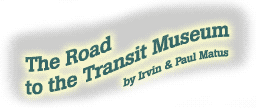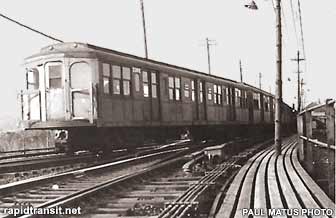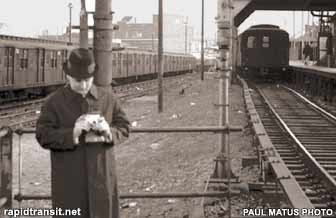

Page 10
After the Fair
High hopes notwithstanding, the museum cars were not spirited off to a safe haven in a still dreamed-of transit museum. A shortage of "Q's", the only BMT cars light enough to operate the Myrtle L, forced the handsome repainted cars to be pressed immediately into service. As a matter of fact, one shop official wanted to cover over the splendid World's Fair coat, restoring 1622 to the maroon and silver scheme of all the other "Q's". Needless to say, it was greeted as a sacrilegious idea and when the official asked about the legend "B. M. T. LINES" on the letterboard the prompt response was: "Myrtle is a BMT Line, isn't it?"
When a scrap list for 161 more Standards was issued it forced the use of the museum Standards on the rush hour Myrtle-Chambers run. And for a short time they turned up on the Canarsie Line. But when the scrap list was cancelled the unit was allowed to enjoy its privileged state in semi-retirement in the Metropolitan Avenue Yard where, often as not, it seemed posed with the museum Q-type, when the latter was not needed in service,
Finally, the Museum
It took quite a while for the Transit Museum to become a reality. Nearly a decade, in fact. The museum had a powerful advocate, Donald W. Harold, a prominent railfan and member (later director) of the TA's Public Information Department.
Don worked hard on this and other projects of importance to the public at large and to rail historians and fans. He enlisted the help of others with an interest in rail preservation, including the folks at the Silver Leaf Rapid Transit company. who published the original article on which this story was based, in the first issue of The Third Rail in 1966.
The Transit Museum became a reality in 1975, housed in the Court Street station of the original IND subway, the only one of the original stations not in use. Despite a half-heartened attempt a decade ago to scuttle the museum as a cost-cutting measure during a previous mayor's administration, the museum serves today as one of the finest examples of a city's history remembered.
Internally the cars were given fresh coats of paint from floor to ceiling while freshly varnished wickers replaced tattered, shredded seats. Some old ad cards and an old IRT map added an extra bit of authenticity for Lo-V 5283.
Transit Day came and did prove to have that something extra, in spite of the overcast skies. At Queensboro Plaza, starting point of the celebration, the celebrities smiled and the motors purred, while the clicks of cameras resounded their owners' enthusiasm.
The workaday rider at Queensboro Plaza, who simply wanted to take the trains in the course of routine, had to be somwhat baffled by it all, but may soon have learned more about the event than he wanted to know. When the doors of the IRT Lo-V train opened, admitting all to its confines, the fans on hand showed their gratitude by impressing the nearest lay rider with a detailed explanation of the significance of it all as they went to the Fair.


Transit Day Standard 2392 trails its brothers leaving Canarsie terminal enroute to Manhattan in passenger service. This right-of-way is one of the few surface running portions on the system.
"Father of the Transit Museum" Don Harold of NYCTA's Public Information office accompanied The Third Rail's reporter that day in 1965 as another Standard waits to leave Canarsie.
Updated
©1966 Silver Leaf Rapid Transit. ©2000 The Composing Stack Inc. All rights reserved